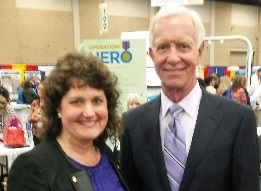Last week I spoke at a convention with Captain “Sully” Sullenberger, the pilot who safely landed a passenger airplane in the Hudson River. That day he faced a surprise –true work drama. All Captain Sully had to do was walk out on the stage and we gave him a standing ovation.
However, what was most impressive is what this hero said immediately following that applause.
Captain Sully:
Thanked the crowd but said he was just a face representing several involved.
Recognized his co-pilot, flight attendants and the air traffic controllers for their actions and clarity.
Discussed how cooperative passengers were in a stressful situation.
Applauded efforts of the NY Firefighters, Red Cross, Coast Guard and emergency personnel.
Then, focused on the leaders in the room. He reminded us we can begin what seems like a normal day at work and then experience a stressful, dramatic change of plans.
True drama can occur in a matter of moments. Our ability to stay calm, think rationally, and decide to lead can significantly affect the direction and lives of others.
Good, hardworking people do a hero’s job and positively contribute to our workplaces each day. Instead of applause and rewards, these everyday heroes face turbulence created by energy drainers. They behave selfishly and divert other’s efforts. These energy vampires suck the joy right out of working…and they do it intentionally.
Here’s what you can do to stop the work drama:
- Know the reality with work drama. Some drama resolves itself with time. Identifying those temporary situations is important. But waiting too long and just reacting to problems as they occur causes a reduction of productivity, a lack of trust, and a negative atmosphere. Work drama may cost you good performers as well as time and resources.
- Avoid actions that don’t work. Stop hoping energy drainers will change on their own. Ignoring them or asking high performers to be patient are not long-term solutions.
The best way to negotiate work drama is to:
Decide if you want to negotiate. Ask yourself: What do I want? What are the solid business and personal reasons for supporting this change? Is this investment worth my time and effort? Is it worth the risk?
Find the right supporters. Ask yourself: Who are the other stakeholders? Why is it in their best interest for others to support my efforts? Is it likely I will have leadership’s support? What do I want our leaders to do? What do I want the organization to do?
Plan for detours and turbulence. Ask: What could go wrong? What is my Plan B? Have I left myself an out? Should I adjust course or proceed as planned? As a leader, do I know how to best protect myself with questions, understanding policy, and documenting?
About Linda: A recognized authority on negotiations, workplace issues and strategic communication, Linda Swindling, JD, CSP is an author, media expert, a “recovering” employment attorney, and a professional speaker. Contact us to book Linda to speak at your event.
